Big Data Analytics in 5G - Doc
VerifiedAdded on 2021/08/16
|12
|3324
|70
AI Summary
Contribute Materials
Your contribution can guide someone’s learning journey. Share your
documents today.
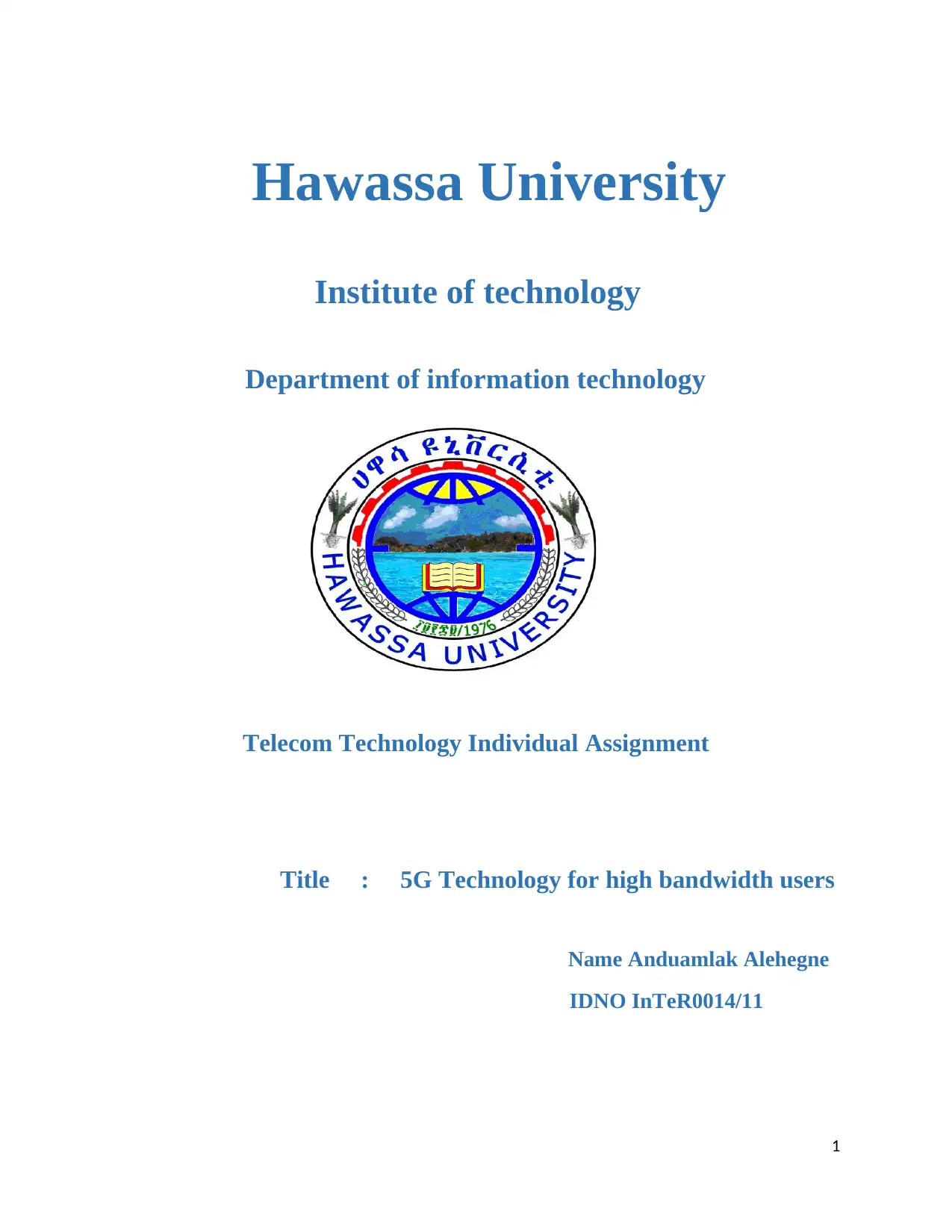
Hawassa University
Institute of technology
Department of information technology
Telecom Technology Individual Assignment
Title : 5G Technology for high bandwidth users
Name Anduamlak Alehegne
IDNO InTeR0014/11
1
Institute of technology
Department of information technology
Telecom Technology Individual Assignment
Title : 5G Technology for high bandwidth users
Name Anduamlak Alehegne
IDNO InTeR0014/11
1
Secure Best Marks with AI Grader
Need help grading? Try our AI Grader for instant feedback on your assignments.
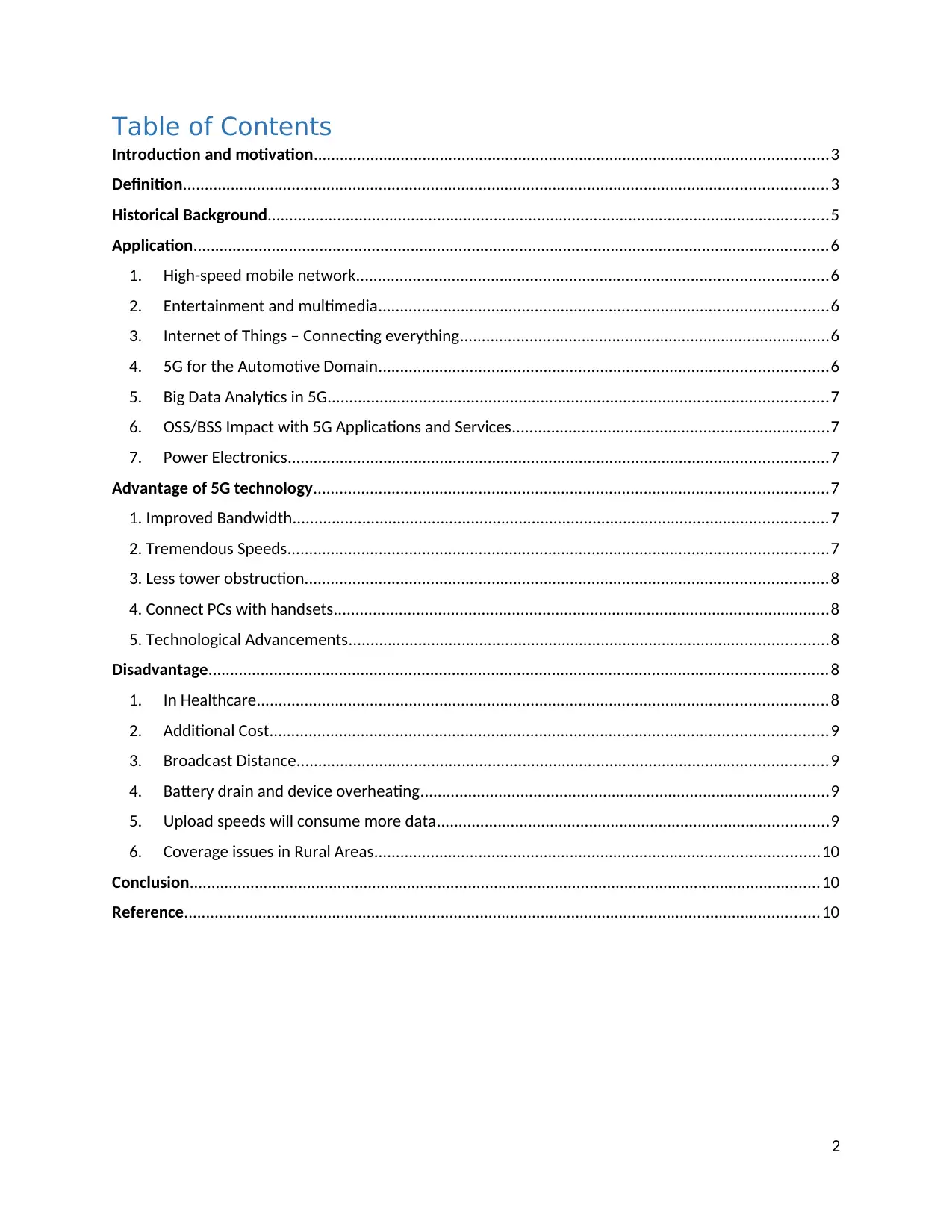
Table of Contents
Introduction and motivation......................................................................................................................3
Definition....................................................................................................................................................3
Historical Background.................................................................................................................................5
Application..................................................................................................................................................6
1. High-speed mobile network............................................................................................................6
2. Entertainment and multimedia.......................................................................................................6
3. Internet of Things – Connecting everything.....................................................................................6
4. 5G for the Automotive Domain.......................................................................................................6
5. Big Data Analytics in 5G...................................................................................................................7
6. OSS/BSS Impact with 5G Applications and Services.........................................................................7
7. Power Electronics............................................................................................................................7
Advantage of 5G technology......................................................................................................................7
1. Improved Bandwidth...........................................................................................................................7
2. Tremendous Speeds............................................................................................................................7
3. Less tower obstruction........................................................................................................................8
4. Connect PCs with handsets..................................................................................................................8
5. Technological Advancements..............................................................................................................8
Disadvantage..............................................................................................................................................8
1. In Healthcare...................................................................................................................................8
2. Additional Cost................................................................................................................................9
3. Broadcast Distance..........................................................................................................................9
4. Battery drain and device overheating..............................................................................................9
5. Upload speeds will consume more data..........................................................................................9
6. Coverage issues in Rural Areas......................................................................................................10
Conclusion.................................................................................................................................................10
Reference..................................................................................................................................................10
2
Introduction and motivation......................................................................................................................3
Definition....................................................................................................................................................3
Historical Background.................................................................................................................................5
Application..................................................................................................................................................6
1. High-speed mobile network............................................................................................................6
2. Entertainment and multimedia.......................................................................................................6
3. Internet of Things – Connecting everything.....................................................................................6
4. 5G for the Automotive Domain.......................................................................................................6
5. Big Data Analytics in 5G...................................................................................................................7
6. OSS/BSS Impact with 5G Applications and Services.........................................................................7
7. Power Electronics............................................................................................................................7
Advantage of 5G technology......................................................................................................................7
1. Improved Bandwidth...........................................................................................................................7
2. Tremendous Speeds............................................................................................................................7
3. Less tower obstruction........................................................................................................................8
4. Connect PCs with handsets..................................................................................................................8
5. Technological Advancements..............................................................................................................8
Disadvantage..............................................................................................................................................8
1. In Healthcare...................................................................................................................................8
2. Additional Cost................................................................................................................................9
3. Broadcast Distance..........................................................................................................................9
4. Battery drain and device overheating..............................................................................................9
5. Upload speeds will consume more data..........................................................................................9
6. Coverage issues in Rural Areas......................................................................................................10
Conclusion.................................................................................................................................................10
Reference..................................................................................................................................................10
2
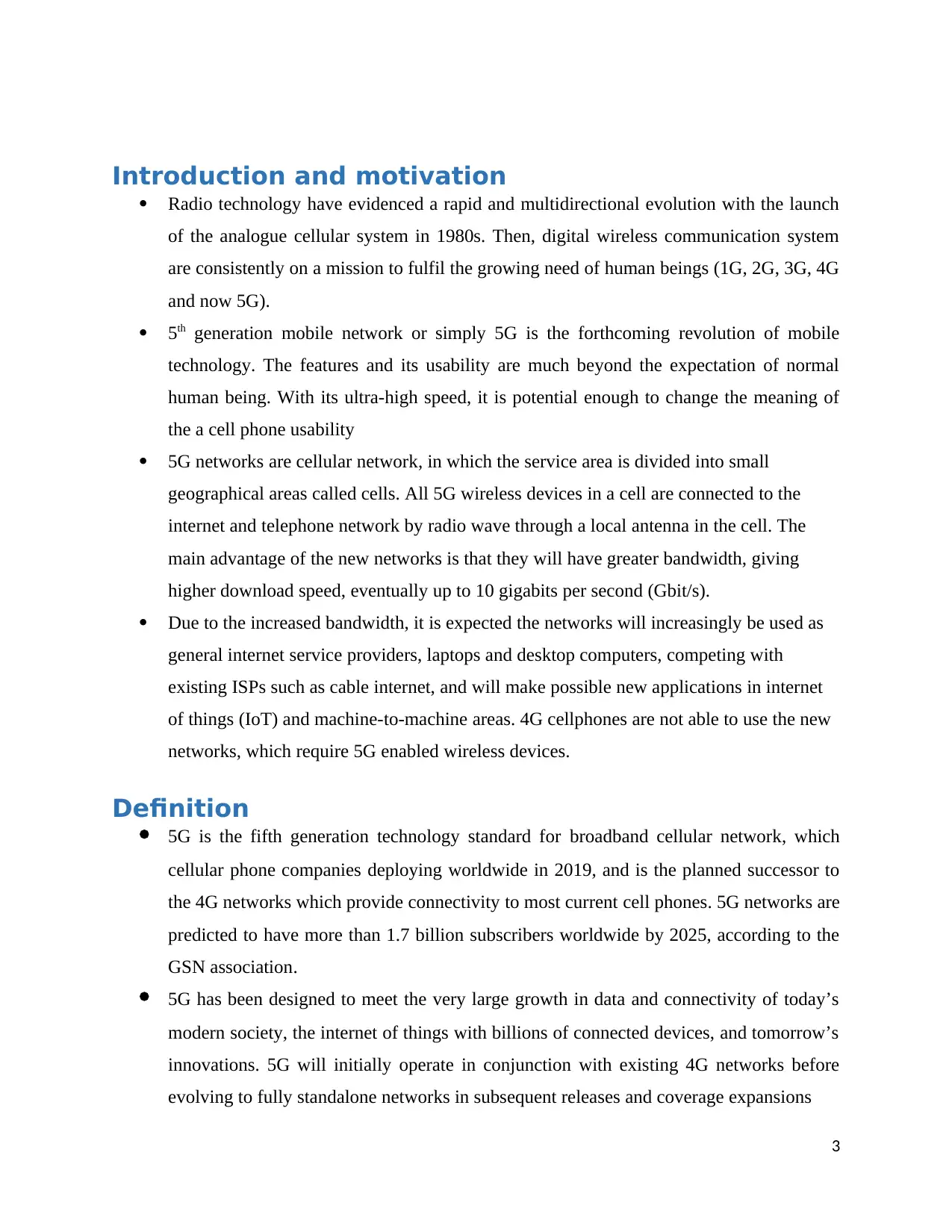
Introduction and motivation
Radio technology have evidenced a rapid and multidirectional evolution with the launch
of the analogue cellular system in 1980s. Then, digital wireless communication system
are consistently on a mission to fulfil the growing need of human beings (1G, 2G, 3G, 4G
and now 5G).
5th generation mobile network or simply 5G is the forthcoming revolution of mobile
technology. The features and its usability are much beyond the expectation of normal
human being. With its ultra-high speed, it is potential enough to change the meaning of
the a cell phone usability
5G networks are cellular network, in which the service area is divided into small
geographical areas called cells. All 5G wireless devices in a cell are connected to the
internet and telephone network by radio wave through a local antenna in the cell. The
main advantage of the new networks is that they will have greater bandwidth, giving
higher download speed, eventually up to 10 gigabits per second (Gbit/s).
Due to the increased bandwidth, it is expected the networks will increasingly be used as
general internet service providers, laptops and desktop computers, competing with
existing ISPs such as cable internet, and will make possible new applications in internet
of things (IoT) and machine-to-machine areas. 4G cellphones are not able to use the new
networks, which require 5G enabled wireless devices.
Definition
5G is the fifth generation technology standard for broadband cellular network, which
cellular phone companies deploying worldwide in 2019, and is the planned successor to
the 4G networks which provide connectivity to most current cell phones. 5G networks are
predicted to have more than 1.7 billion subscribers worldwide by 2025, according to the
GSN association.
5G has been designed to meet the very large growth in data and connectivity of today’s
modern society, the internet of things with billions of connected devices, and tomorrow’s
innovations. 5G will initially operate in conjunction with existing 4G networks before
evolving to fully standalone networks in subsequent releases and coverage expansions
3
Radio technology have evidenced a rapid and multidirectional evolution with the launch
of the analogue cellular system in 1980s. Then, digital wireless communication system
are consistently on a mission to fulfil the growing need of human beings (1G, 2G, 3G, 4G
and now 5G).
5th generation mobile network or simply 5G is the forthcoming revolution of mobile
technology. The features and its usability are much beyond the expectation of normal
human being. With its ultra-high speed, it is potential enough to change the meaning of
the a cell phone usability
5G networks are cellular network, in which the service area is divided into small
geographical areas called cells. All 5G wireless devices in a cell are connected to the
internet and telephone network by radio wave through a local antenna in the cell. The
main advantage of the new networks is that they will have greater bandwidth, giving
higher download speed, eventually up to 10 gigabits per second (Gbit/s).
Due to the increased bandwidth, it is expected the networks will increasingly be used as
general internet service providers, laptops and desktop computers, competing with
existing ISPs such as cable internet, and will make possible new applications in internet
of things (IoT) and machine-to-machine areas. 4G cellphones are not able to use the new
networks, which require 5G enabled wireless devices.
Definition
5G is the fifth generation technology standard for broadband cellular network, which
cellular phone companies deploying worldwide in 2019, and is the planned successor to
the 4G networks which provide connectivity to most current cell phones. 5G networks are
predicted to have more than 1.7 billion subscribers worldwide by 2025, according to the
GSN association.
5G has been designed to meet the very large growth in data and connectivity of today’s
modern society, the internet of things with billions of connected devices, and tomorrow’s
innovations. 5G will initially operate in conjunction with existing 4G networks before
evolving to fully standalone networks in subsequent releases and coverage expansions
3
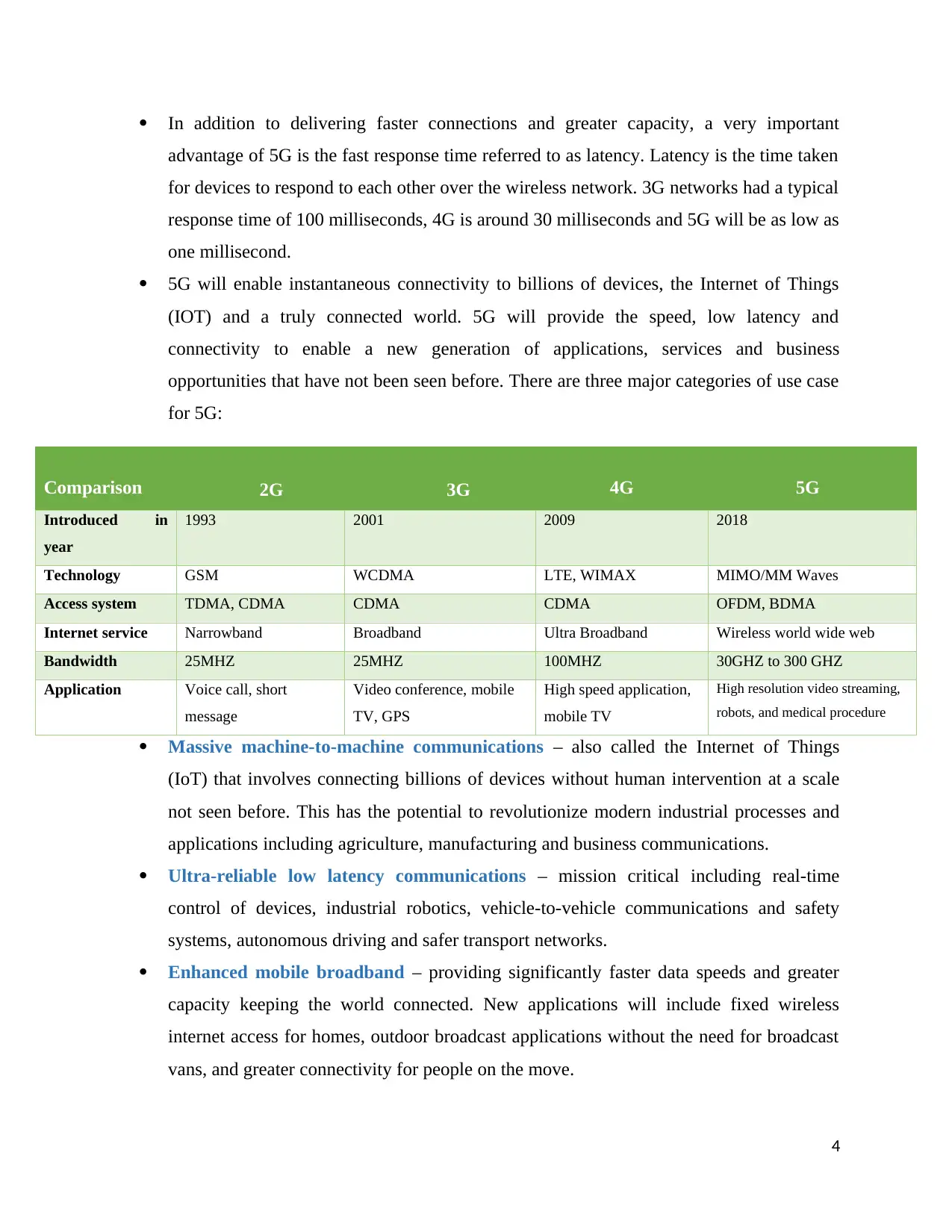
In addition to delivering faster connections and greater capacity, a very important
advantage of 5G is the fast response time referred to as latency. Latency is the time taken
for devices to respond to each other over the wireless network. 3G networks had a typical
response time of 100 milliseconds, 4G is around 30 milliseconds and 5G will be as low as
one millisecond.
5G will enable instantaneous connectivity to billions of devices, the Internet of Things
(IOT) and a truly connected world. 5G will provide the speed, low latency and
connectivity to enable a new generation of applications, services and business
opportunities that have not been seen before. There are three major categories of use case
for 5G:
Comparison 2G 3G 4G 5G
Introduced in
year
1993 2001 2009 2018
Technology GSM WCDMA LTE, WIMAX MIMO/MM Waves
Access system TDMA, CDMA CDMA CDMA OFDM, BDMA
Internet service Narrowband Broadband Ultra Broadband Wireless world wide web
Bandwidth 25MHZ 25MHZ 100MHZ 30GHZ to 300 GHZ
Application Voice call, short
message
Video conference, mobile
TV, GPS
High speed application,
mobile TV
High resolution video streaming,
robots, and medical procedure
Massive machine-to-machine communications – also called the Internet of Things
(IoT) that involves connecting billions of devices without human intervention at a scale
not seen before. This has the potential to revolutionize modern industrial processes and
applications including agriculture, manufacturing and business communications.
Ultra-reliable low latency communications – mission critical including real-time
control of devices, industrial robotics, vehicle-to-vehicle communications and safety
systems, autonomous driving and safer transport networks.
Enhanced mobile broadband – providing significantly faster data speeds and greater
capacity keeping the world connected. New applications will include fixed wireless
internet access for homes, outdoor broadcast applications without the need for broadcast
vans, and greater connectivity for people on the move.
4
advantage of 5G is the fast response time referred to as latency. Latency is the time taken
for devices to respond to each other over the wireless network. 3G networks had a typical
response time of 100 milliseconds, 4G is around 30 milliseconds and 5G will be as low as
one millisecond.
5G will enable instantaneous connectivity to billions of devices, the Internet of Things
(IOT) and a truly connected world. 5G will provide the speed, low latency and
connectivity to enable a new generation of applications, services and business
opportunities that have not been seen before. There are three major categories of use case
for 5G:
Comparison 2G 3G 4G 5G
Introduced in
year
1993 2001 2009 2018
Technology GSM WCDMA LTE, WIMAX MIMO/MM Waves
Access system TDMA, CDMA CDMA CDMA OFDM, BDMA
Internet service Narrowband Broadband Ultra Broadband Wireless world wide web
Bandwidth 25MHZ 25MHZ 100MHZ 30GHZ to 300 GHZ
Application Voice call, short
message
Video conference, mobile
TV, GPS
High speed application,
mobile TV
High resolution video streaming,
robots, and medical procedure
Massive machine-to-machine communications – also called the Internet of Things
(IoT) that involves connecting billions of devices without human intervention at a scale
not seen before. This has the potential to revolutionize modern industrial processes and
applications including agriculture, manufacturing and business communications.
Ultra-reliable low latency communications – mission critical including real-time
control of devices, industrial robotics, vehicle-to-vehicle communications and safety
systems, autonomous driving and safer transport networks.
Enhanced mobile broadband – providing significantly faster data speeds and greater
capacity keeping the world connected. New applications will include fixed wireless
internet access for homes, outdoor broadcast applications without the need for broadcast
vans, and greater connectivity for people on the move.
4
Secure Best Marks with AI Grader
Need help grading? Try our AI Grader for instant feedback on your assignments.
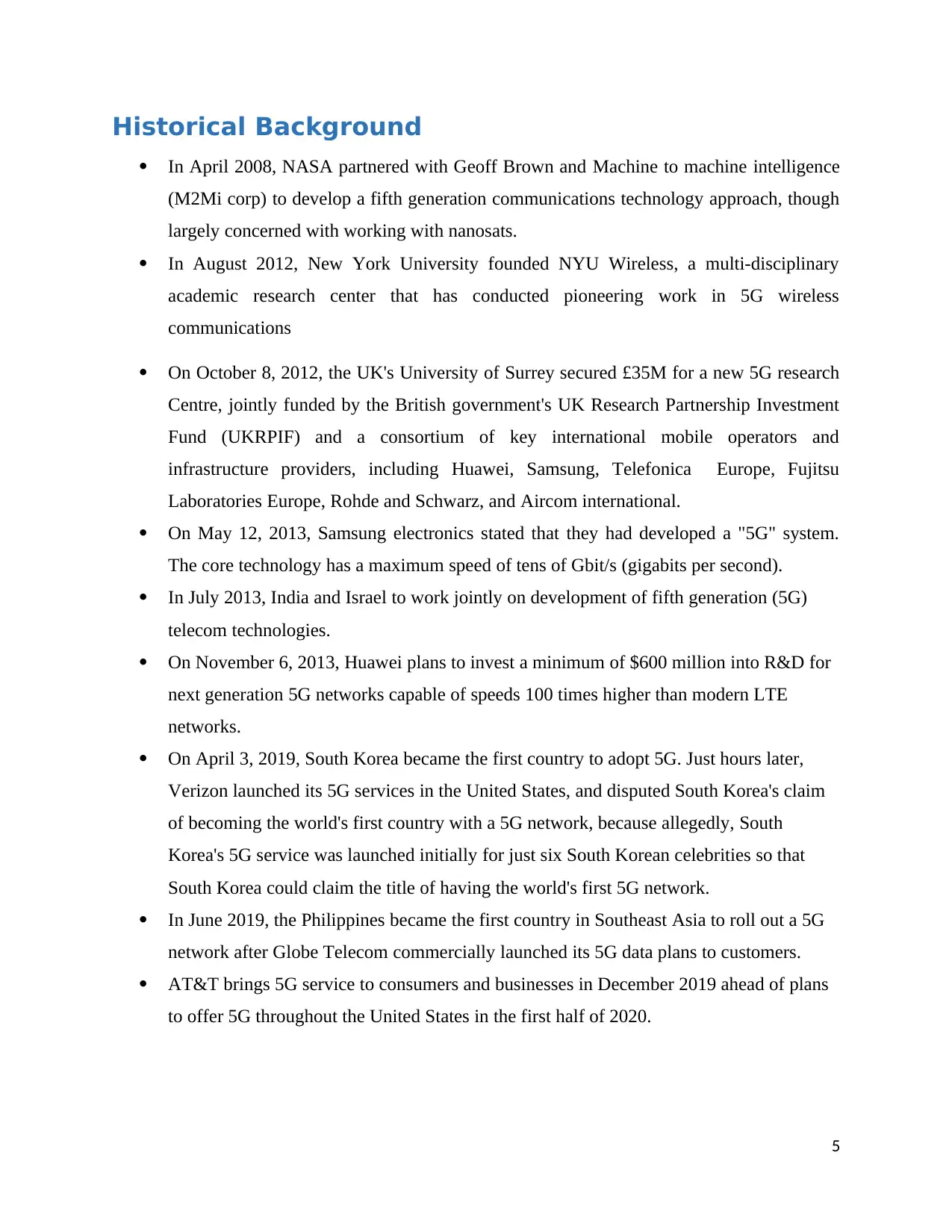
Historical Background
In April 2008, NASA partnered with Geoff Brown and Machine to machine intelligence
(M2Mi corp) to develop a fifth generation communications technology approach, though
largely concerned with working with nanosats.
In August 2012, New York University founded NYU Wireless, a multi-disciplinary
academic research center that has conducted pioneering work in 5G wireless
communications
On October 8, 2012, the UK's University of Surrey secured £35M for a new 5G research
Centre, jointly funded by the British government's UK Research Partnership Investment
Fund (UKRPIF) and a consortium of key international mobile operators and
infrastructure providers, including Huawei, Samsung, Telefonica Europe, Fujitsu
Laboratories Europe, Rohde and Schwarz, and Aircom international.
On May 12, 2013, Samsung electronics stated that they had developed a "5G" system.
The core technology has a maximum speed of tens of Gbit/s (gigabits per second).
In July 2013, India and Israel to work jointly on development of fifth generation (5G)
telecom technologies.
On November 6, 2013, Huawei plans to invest a minimum of $600 million into R&D for
next generation 5G networks capable of speeds 100 times higher than modern LTE
networks.
On April 3, 2019, South Korea became the first country to adopt 5G. Just hours later,
Verizon launched its 5G services in the United States, and disputed South Korea's claim
of becoming the world's first country with a 5G network, because allegedly, South
Korea's 5G service was launched initially for just six South Korean celebrities so that
South Korea could claim the title of having the world's first 5G network.
In June 2019, the Philippines became the first country in Southeast Asia to roll out a 5G
network after Globe Telecom commercially launched its 5G data plans to customers.
AT&T brings 5G service to consumers and businesses in December 2019 ahead of plans
to offer 5G throughout the United States in the first half of 2020.
5
In April 2008, NASA partnered with Geoff Brown and Machine to machine intelligence
(M2Mi corp) to develop a fifth generation communications technology approach, though
largely concerned with working with nanosats.
In August 2012, New York University founded NYU Wireless, a multi-disciplinary
academic research center that has conducted pioneering work in 5G wireless
communications
On October 8, 2012, the UK's University of Surrey secured £35M for a new 5G research
Centre, jointly funded by the British government's UK Research Partnership Investment
Fund (UKRPIF) and a consortium of key international mobile operators and
infrastructure providers, including Huawei, Samsung, Telefonica Europe, Fujitsu
Laboratories Europe, Rohde and Schwarz, and Aircom international.
On May 12, 2013, Samsung electronics stated that they had developed a "5G" system.
The core technology has a maximum speed of tens of Gbit/s (gigabits per second).
In July 2013, India and Israel to work jointly on development of fifth generation (5G)
telecom technologies.
On November 6, 2013, Huawei plans to invest a minimum of $600 million into R&D for
next generation 5G networks capable of speeds 100 times higher than modern LTE
networks.
On April 3, 2019, South Korea became the first country to adopt 5G. Just hours later,
Verizon launched its 5G services in the United States, and disputed South Korea's claim
of becoming the world's first country with a 5G network, because allegedly, South
Korea's 5G service was launched initially for just six South Korean celebrities so that
South Korea could claim the title of having the world's first 5G network.
In June 2019, the Philippines became the first country in Southeast Asia to roll out a 5G
network after Globe Telecom commercially launched its 5G data plans to customers.
AT&T brings 5G service to consumers and businesses in December 2019 ahead of plans
to offer 5G throughout the United States in the first half of 2020.
5
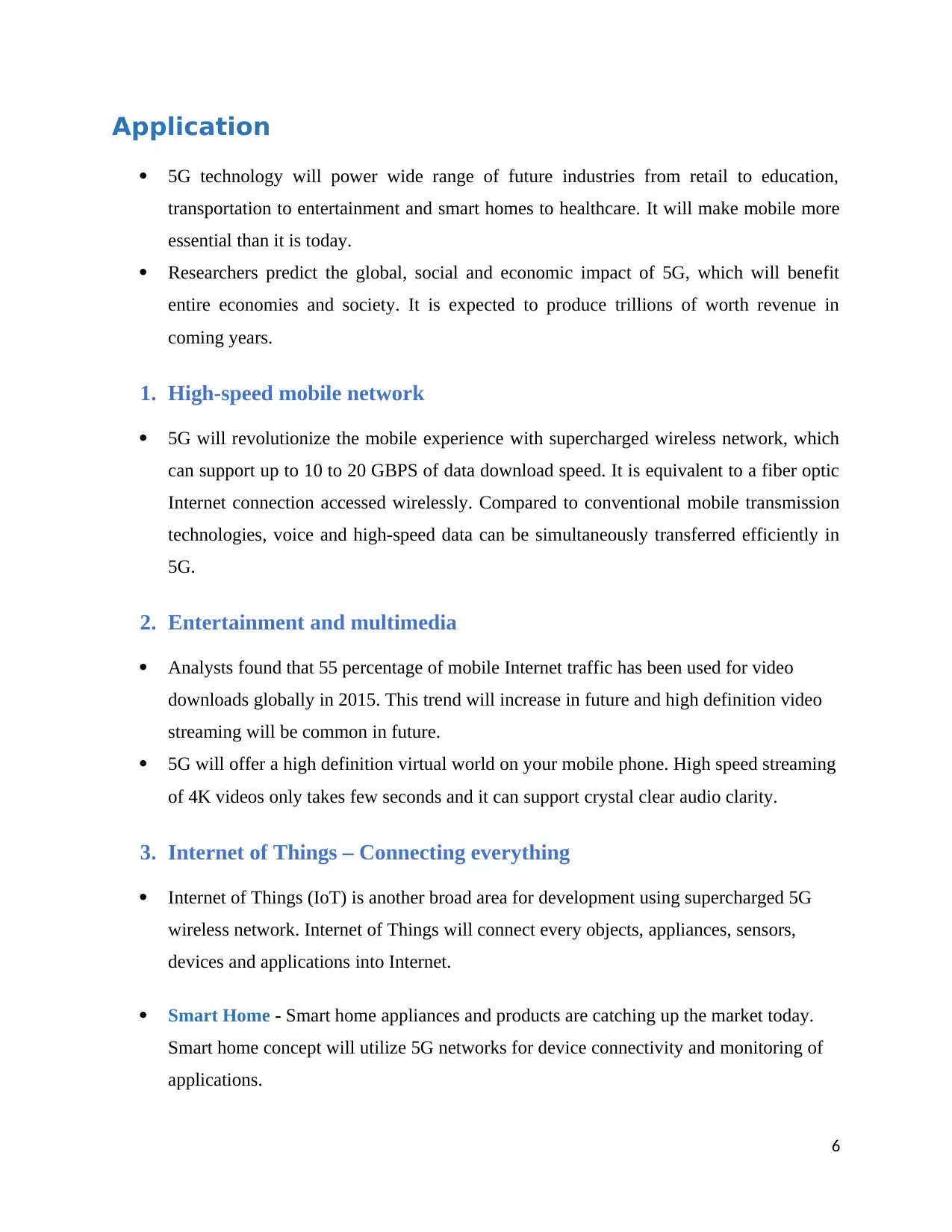
Application
5G technology will power wide range of future industries from retail to education,
transportation to entertainment and smart homes to healthcare. It will make mobile more
essential than it is today.
Researchers predict the global, social and economic impact of 5G, which will benefit
entire economies and society. It is expected to produce trillions of worth revenue in
coming years.
1. High-speed mobile network
5G will revolutionize the mobile experience with supercharged wireless network, which
can support up to 10 to 20 GBPS of data download speed. It is equivalent to a fiber optic
Internet connection accessed wirelessly. Compared to conventional mobile transmission
technologies, voice and high-speed data can be simultaneously transferred efficiently in
5G.
2. Entertainment and multimedia
Analysts found that 55 percentage of mobile Internet traffic has been used for video
downloads globally in 2015. This trend will increase in future and high definition video
streaming will be common in future.
5G will offer a high definition virtual world on your mobile phone. High speed streaming
of 4K videos only takes few seconds and it can support crystal clear audio clarity.
3. Internet of Things – Connecting everything
Internet of Things (IoT) is another broad area for development using supercharged 5G
wireless network. Internet of Things will connect every objects, appliances, sensors,
devices and applications into Internet.
Smart Home - Smart home appliances and products are catching up the market today.
Smart home concept will utilize 5G networks for device connectivity and monitoring of
applications.
6
5G technology will power wide range of future industries from retail to education,
transportation to entertainment and smart homes to healthcare. It will make mobile more
essential than it is today.
Researchers predict the global, social and economic impact of 5G, which will benefit
entire economies and society. It is expected to produce trillions of worth revenue in
coming years.
1. High-speed mobile network
5G will revolutionize the mobile experience with supercharged wireless network, which
can support up to 10 to 20 GBPS of data download speed. It is equivalent to a fiber optic
Internet connection accessed wirelessly. Compared to conventional mobile transmission
technologies, voice and high-speed data can be simultaneously transferred efficiently in
5G.
2. Entertainment and multimedia
Analysts found that 55 percentage of mobile Internet traffic has been used for video
downloads globally in 2015. This trend will increase in future and high definition video
streaming will be common in future.
5G will offer a high definition virtual world on your mobile phone. High speed streaming
of 4K videos only takes few seconds and it can support crystal clear audio clarity.
3. Internet of Things – Connecting everything
Internet of Things (IoT) is another broad area for development using supercharged 5G
wireless network. Internet of Things will connect every objects, appliances, sensors,
devices and applications into Internet.
Smart Home - Smart home appliances and products are catching up the market today.
Smart home concept will utilize 5G networks for device connectivity and monitoring of
applications.
6
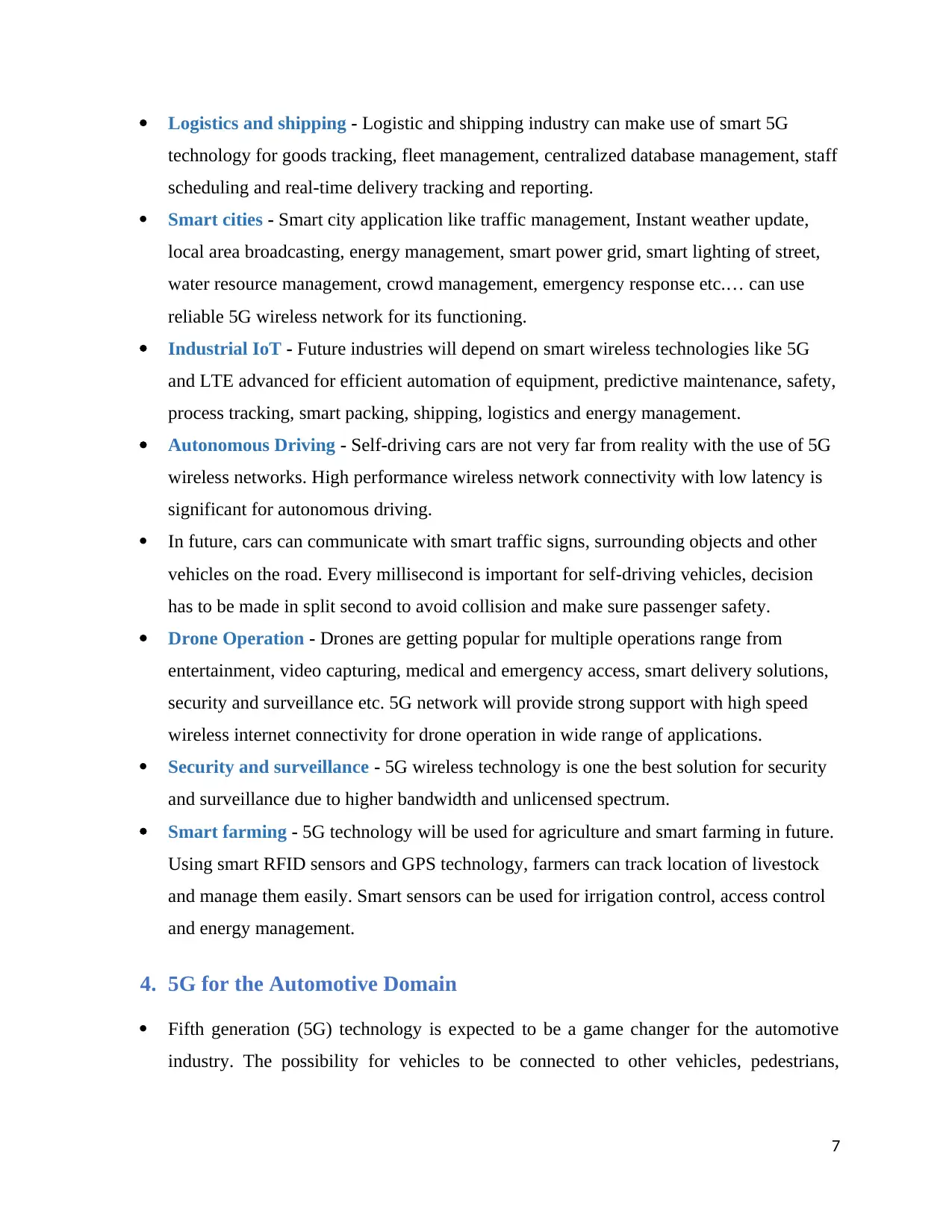
Logistics and shipping - Logistic and shipping industry can make use of smart 5G
technology for goods tracking, fleet management, centralized database management, staff
scheduling and real-time delivery tracking and reporting.
Smart cities - Smart city application like traffic management, Instant weather update,
local area broadcasting, energy management, smart power grid, smart lighting of street,
water resource management, crowd management, emergency response etc.… can use
reliable 5G wireless network for its functioning.
Industrial IoT - Future industries will depend on smart wireless technologies like 5G
and LTE advanced for efficient automation of equipment, predictive maintenance, safety,
process tracking, smart packing, shipping, logistics and energy management.
Autonomous Driving - Self-driving cars are not very far from reality with the use of 5G
wireless networks. High performance wireless network connectivity with low latency is
significant for autonomous driving.
In future, cars can communicate with smart traffic signs, surrounding objects and other
vehicles on the road. Every millisecond is important for self-driving vehicles, decision
has to be made in split second to avoid collision and make sure passenger safety.
Drone Operation - Drones are getting popular for multiple operations range from
entertainment, video capturing, medical and emergency access, smart delivery solutions,
security and surveillance etc. 5G network will provide strong support with high speed
wireless internet connectivity for drone operation in wide range of applications.
Security and surveillance - 5G wireless technology is one the best solution for security
and surveillance due to higher bandwidth and unlicensed spectrum.
Smart farming - 5G technology will be used for agriculture and smart farming in future.
Using smart RFID sensors and GPS technology, farmers can track location of livestock
and manage them easily. Smart sensors can be used for irrigation control, access control
and energy management.
4. 5G for the Automotive Domain
Fifth generation (5G) technology is expected to be a game changer for the automotive
industry. The possibility for vehicles to be connected to other vehicles, pedestrians,
7
technology for goods tracking, fleet management, centralized database management, staff
scheduling and real-time delivery tracking and reporting.
Smart cities - Smart city application like traffic management, Instant weather update,
local area broadcasting, energy management, smart power grid, smart lighting of street,
water resource management, crowd management, emergency response etc.… can use
reliable 5G wireless network for its functioning.
Industrial IoT - Future industries will depend on smart wireless technologies like 5G
and LTE advanced for efficient automation of equipment, predictive maintenance, safety,
process tracking, smart packing, shipping, logistics and energy management.
Autonomous Driving - Self-driving cars are not very far from reality with the use of 5G
wireless networks. High performance wireless network connectivity with low latency is
significant for autonomous driving.
In future, cars can communicate with smart traffic signs, surrounding objects and other
vehicles on the road. Every millisecond is important for self-driving vehicles, decision
has to be made in split second to avoid collision and make sure passenger safety.
Drone Operation - Drones are getting popular for multiple operations range from
entertainment, video capturing, medical and emergency access, smart delivery solutions,
security and surveillance etc. 5G network will provide strong support with high speed
wireless internet connectivity for drone operation in wide range of applications.
Security and surveillance - 5G wireless technology is one the best solution for security
and surveillance due to higher bandwidth and unlicensed spectrum.
Smart farming - 5G technology will be used for agriculture and smart farming in future.
Using smart RFID sensors and GPS technology, farmers can track location of livestock
and manage them easily. Smart sensors can be used for irrigation control, access control
and energy management.
4. 5G for the Automotive Domain
Fifth generation (5G) technology is expected to be a game changer for the automotive
industry. The possibility for vehicles to be connected to other vehicles, pedestrians,
7
Paraphrase This Document
Need a fresh take? Get an instant paraphrase of this document with our AI Paraphraser
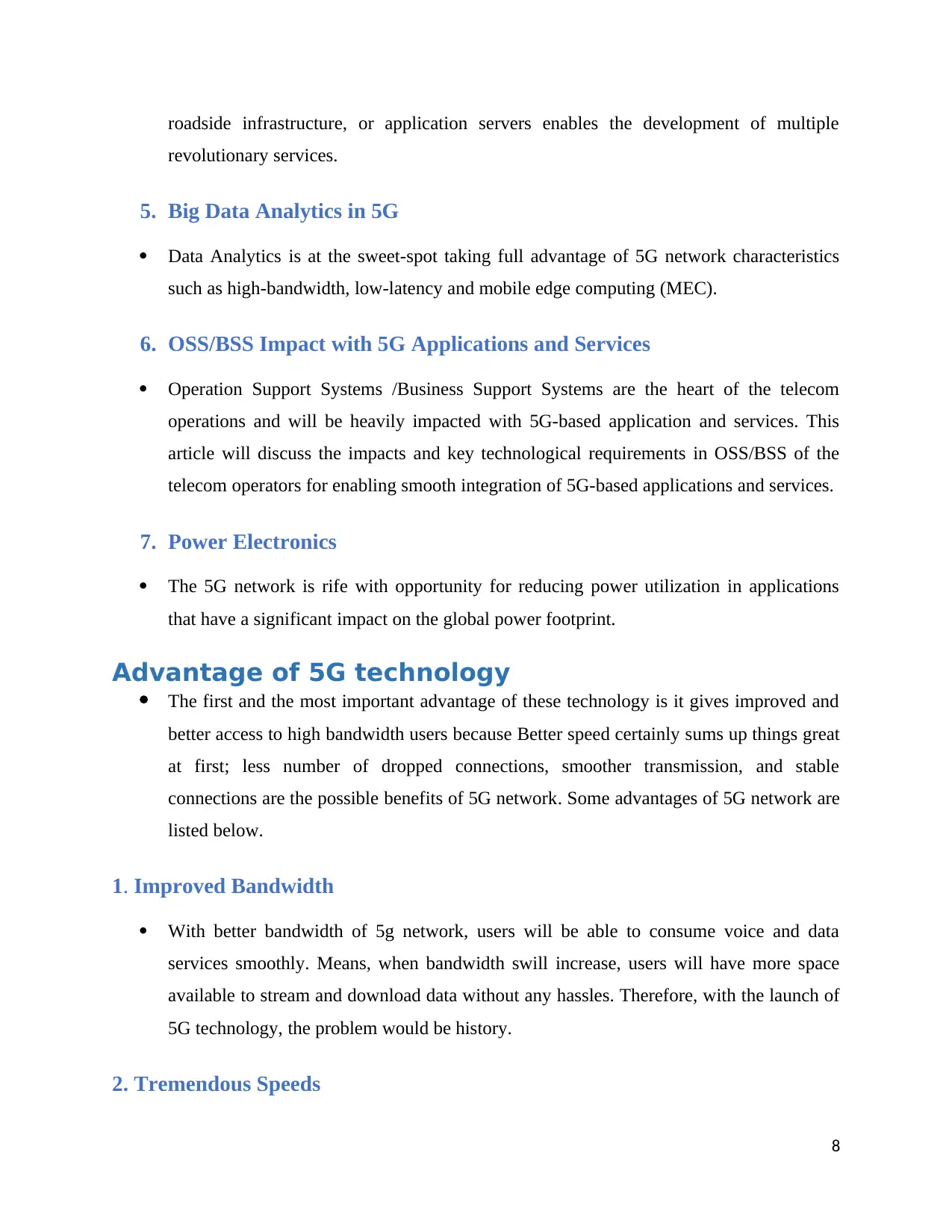
roadside infrastructure, or application servers enables the development of multiple
revolutionary services.
5. Big Data Analytics in 5G
Data Analytics is at the sweet-spot taking full advantage of 5G network characteristics
such as high-bandwidth, low-latency and mobile edge computing (MEC).
6. OSS/BSS Impact with 5G Applications and Services
Operation Support Systems /Business Support Systems are the heart of the telecom
operations and will be heavily impacted with 5G-based application and services. This
article will discuss the impacts and key technological requirements in OSS/BSS of the
telecom operators for enabling smooth integration of 5G-based applications and services.
7. Power Electronics
The 5G network is rife with opportunity for reducing power utilization in applications
that have a significant impact on the global power footprint.
Advantage of 5G technology
The first and the most important advantage of these technology is it gives improved and
better access to high bandwidth users because Better speed certainly sums up things great
at first; less number of dropped connections, smoother transmission, and stable
connections are the possible benefits of 5G network. Some advantages of 5G network are
listed below.
1. Improved Bandwidth
With better bandwidth of 5g network, users will be able to consume voice and data
services smoothly. Means, when bandwidth swill increase, users will have more space
available to stream and download data without any hassles. Therefore, with the launch of
5G technology, the problem would be history.
2. Tremendous Speeds
8
revolutionary services.
5. Big Data Analytics in 5G
Data Analytics is at the sweet-spot taking full advantage of 5G network characteristics
such as high-bandwidth, low-latency and mobile edge computing (MEC).
6. OSS/BSS Impact with 5G Applications and Services
Operation Support Systems /Business Support Systems are the heart of the telecom
operations and will be heavily impacted with 5G-based application and services. This
article will discuss the impacts and key technological requirements in OSS/BSS of the
telecom operators for enabling smooth integration of 5G-based applications and services.
7. Power Electronics
The 5G network is rife with opportunity for reducing power utilization in applications
that have a significant impact on the global power footprint.
Advantage of 5G technology
The first and the most important advantage of these technology is it gives improved and
better access to high bandwidth users because Better speed certainly sums up things great
at first; less number of dropped connections, smoother transmission, and stable
connections are the possible benefits of 5G network. Some advantages of 5G network are
listed below.
1. Improved Bandwidth
With better bandwidth of 5g network, users will be able to consume voice and data
services smoothly. Means, when bandwidth swill increase, users will have more space
available to stream and download data without any hassles. Therefore, with the launch of
5G technology, the problem would be history.
2. Tremendous Speeds
8
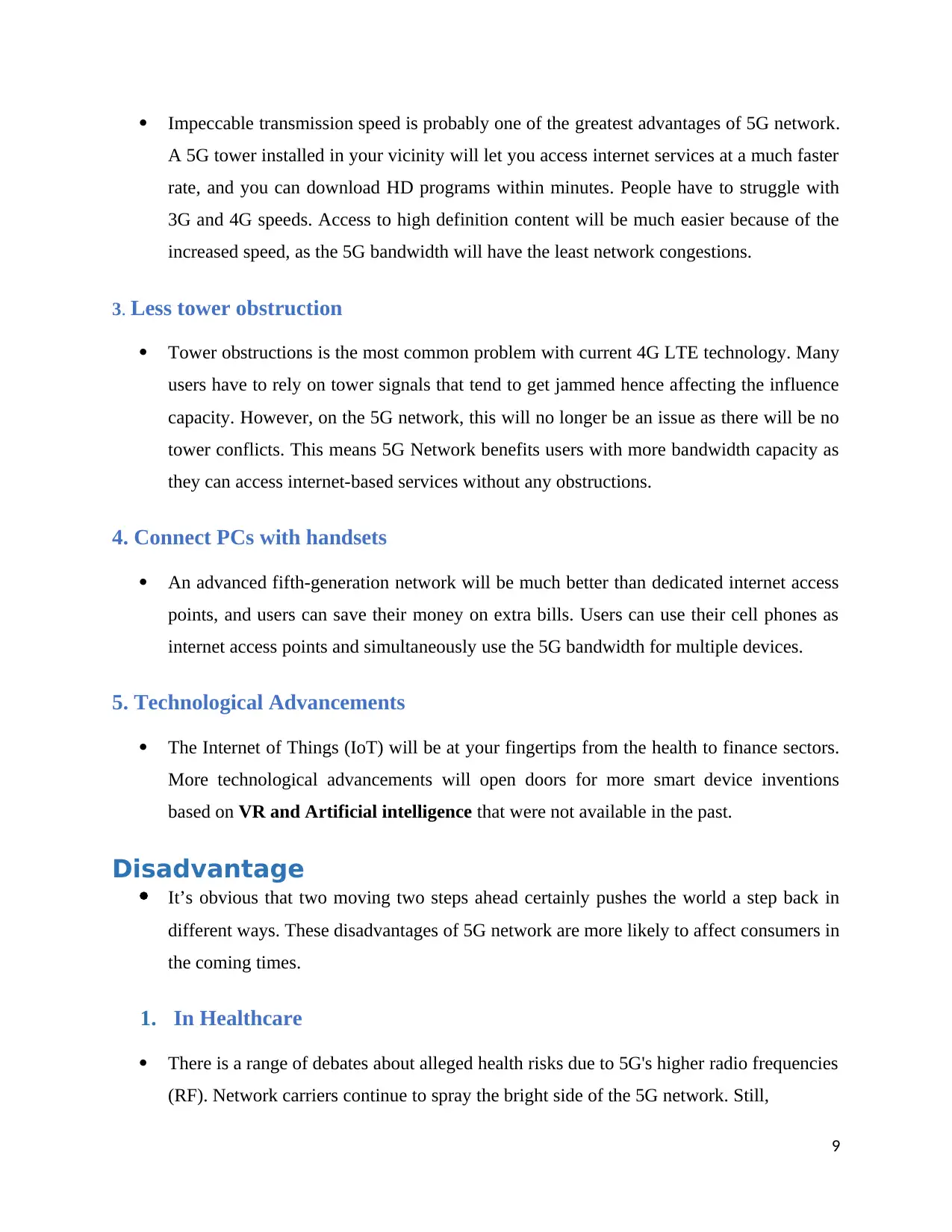
Impeccable transmission speed is probably one of the greatest advantages of 5G network.
A 5G tower installed in your vicinity will let you access internet services at a much faster
rate, and you can download HD programs within minutes. People have to struggle with
3G and 4G speeds. Access to high definition content will be much easier because of the
increased speed, as the 5G bandwidth will have the least network congestions.
3. Less tower obstruction
Tower obstructions is the most common problem with current 4G LTE technology. Many
users have to rely on tower signals that tend to get jammed hence affecting the influence
capacity. However, on the 5G network, this will no longer be an issue as there will be no
tower conflicts. This means 5G Network benefits users with more bandwidth capacity as
they can access internet-based services without any obstructions.
4. Connect PCs with handsets
An advanced fifth-generation network will be much better than dedicated internet access
points, and users can save their money on extra bills. Users can use their cell phones as
internet access points and simultaneously use the 5G bandwidth for multiple devices.
5. Technological Advancements
The Internet of Things (IoT) will be at your fingertips from the health to finance sectors.
More technological advancements will open doors for more smart device inventions
based on VR and Artificial intelligence that were not available in the past.
Disadvantage
It’s obvious that two moving two steps ahead certainly pushes the world a step back in
different ways. These disadvantages of 5G network are more likely to affect consumers in
the coming times.
1. In Healthcare
There is a range of debates about alleged health risks due to 5G's higher radio frequencies
(RF). Network carriers continue to spray the bright side of the 5G network. Still,
9
A 5G tower installed in your vicinity will let you access internet services at a much faster
rate, and you can download HD programs within minutes. People have to struggle with
3G and 4G speeds. Access to high definition content will be much easier because of the
increased speed, as the 5G bandwidth will have the least network congestions.
3. Less tower obstruction
Tower obstructions is the most common problem with current 4G LTE technology. Many
users have to rely on tower signals that tend to get jammed hence affecting the influence
capacity. However, on the 5G network, this will no longer be an issue as there will be no
tower conflicts. This means 5G Network benefits users with more bandwidth capacity as
they can access internet-based services without any obstructions.
4. Connect PCs with handsets
An advanced fifth-generation network will be much better than dedicated internet access
points, and users can save their money on extra bills. Users can use their cell phones as
internet access points and simultaneously use the 5G bandwidth for multiple devices.
5. Technological Advancements
The Internet of Things (IoT) will be at your fingertips from the health to finance sectors.
More technological advancements will open doors for more smart device inventions
based on VR and Artificial intelligence that were not available in the past.
Disadvantage
It’s obvious that two moving two steps ahead certainly pushes the world a step back in
different ways. These disadvantages of 5G network are more likely to affect consumers in
the coming times.
1. In Healthcare
There is a range of debates about alleged health risks due to 5G's higher radio frequencies
(RF). Network carriers continue to spray the bright side of the 5G network. Still,
9
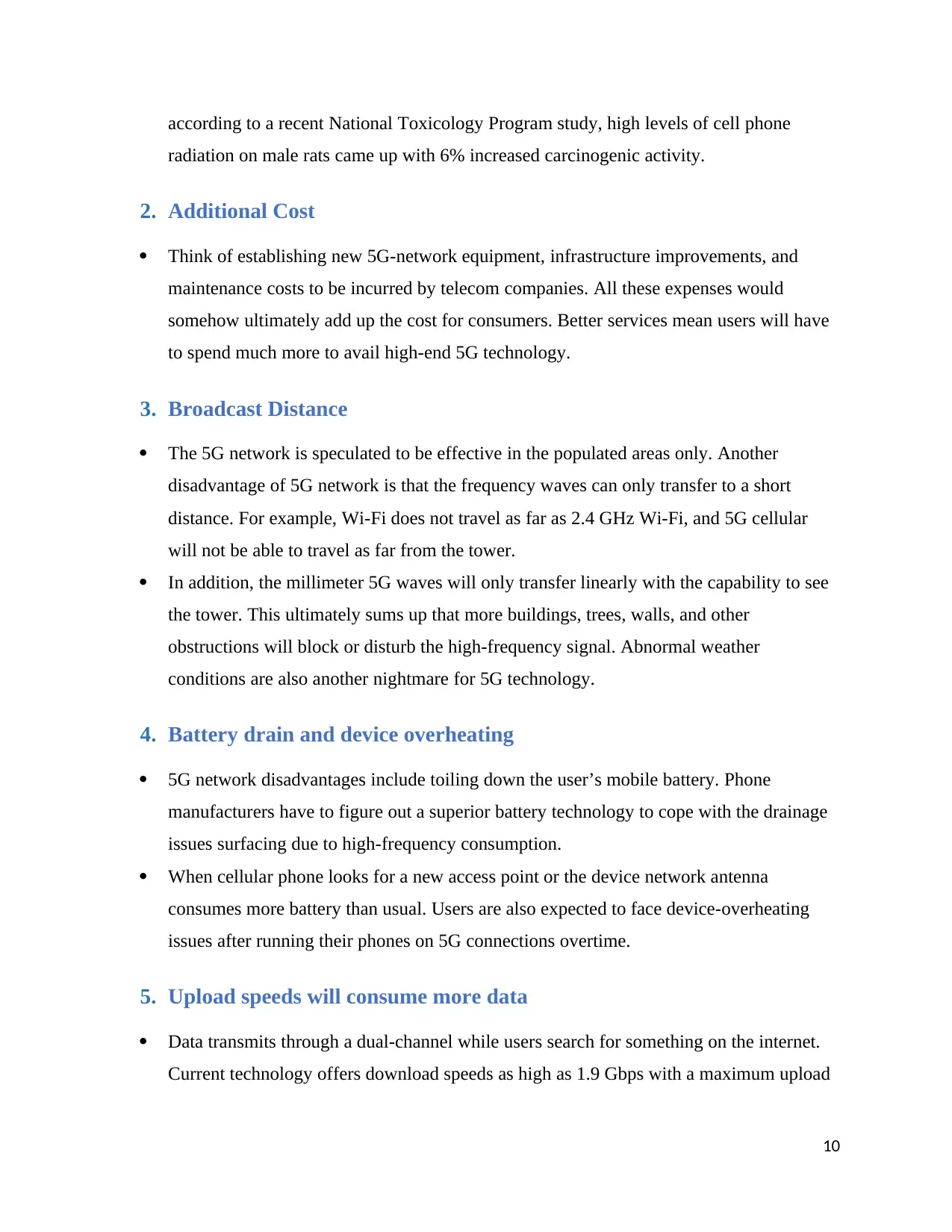
according to a recent National Toxicology Program study, high levels of cell phone
radiation on male rats came up with 6% increased carcinogenic activity.
2. Additional Cost
Think of establishing new 5G-network equipment, infrastructure improvements, and
maintenance costs to be incurred by telecom companies. All these expenses would
somehow ultimately add up the cost for consumers. Better services mean users will have
to spend much more to avail high-end 5G technology.
3. Broadcast Distance
The 5G network is speculated to be effective in the populated areas only. Another
disadvantage of 5G network is that the frequency waves can only transfer to a short
distance. For example, Wi-Fi does not travel as far as 2.4 GHz Wi-Fi, and 5G cellular
will not be able to travel as far from the tower.
In addition, the millimeter 5G waves will only transfer linearly with the capability to see
the tower. This ultimately sums up that more buildings, trees, walls, and other
obstructions will block or disturb the high-frequency signal. Abnormal weather
conditions are also another nightmare for 5G technology.
4. Battery drain and device overheating
5G network disadvantages include toiling down the user’s mobile battery. Phone
manufacturers have to figure out a superior battery technology to cope with the drainage
issues surfacing due to high-frequency consumption.
When cellular phone looks for a new access point or the device network antenna
consumes more battery than usual. Users are also expected to face device-overheating
issues after running their phones on 5G connections overtime.
5. Upload speeds will consume more data
Data transmits through a dual-channel while users search for something on the internet.
Current technology offers download speeds as high as 1.9 Gbps with a maximum upload
10
radiation on male rats came up with 6% increased carcinogenic activity.
2. Additional Cost
Think of establishing new 5G-network equipment, infrastructure improvements, and
maintenance costs to be incurred by telecom companies. All these expenses would
somehow ultimately add up the cost for consumers. Better services mean users will have
to spend much more to avail high-end 5G technology.
3. Broadcast Distance
The 5G network is speculated to be effective in the populated areas only. Another
disadvantage of 5G network is that the frequency waves can only transfer to a short
distance. For example, Wi-Fi does not travel as far as 2.4 GHz Wi-Fi, and 5G cellular
will not be able to travel as far from the tower.
In addition, the millimeter 5G waves will only transfer linearly with the capability to see
the tower. This ultimately sums up that more buildings, trees, walls, and other
obstructions will block or disturb the high-frequency signal. Abnormal weather
conditions are also another nightmare for 5G technology.
4. Battery drain and device overheating
5G network disadvantages include toiling down the user’s mobile battery. Phone
manufacturers have to figure out a superior battery technology to cope with the drainage
issues surfacing due to high-frequency consumption.
When cellular phone looks for a new access point or the device network antenna
consumes more battery than usual. Users are also expected to face device-overheating
issues after running their phones on 5G connections overtime.
5. Upload speeds will consume more data
Data transmits through a dual-channel while users search for something on the internet.
Current technology offers download speeds as high as 1.9 Gbps with a maximum upload
10
Secure Best Marks with AI Grader
Need help grading? Try our AI Grader for instant feedback on your assignments.
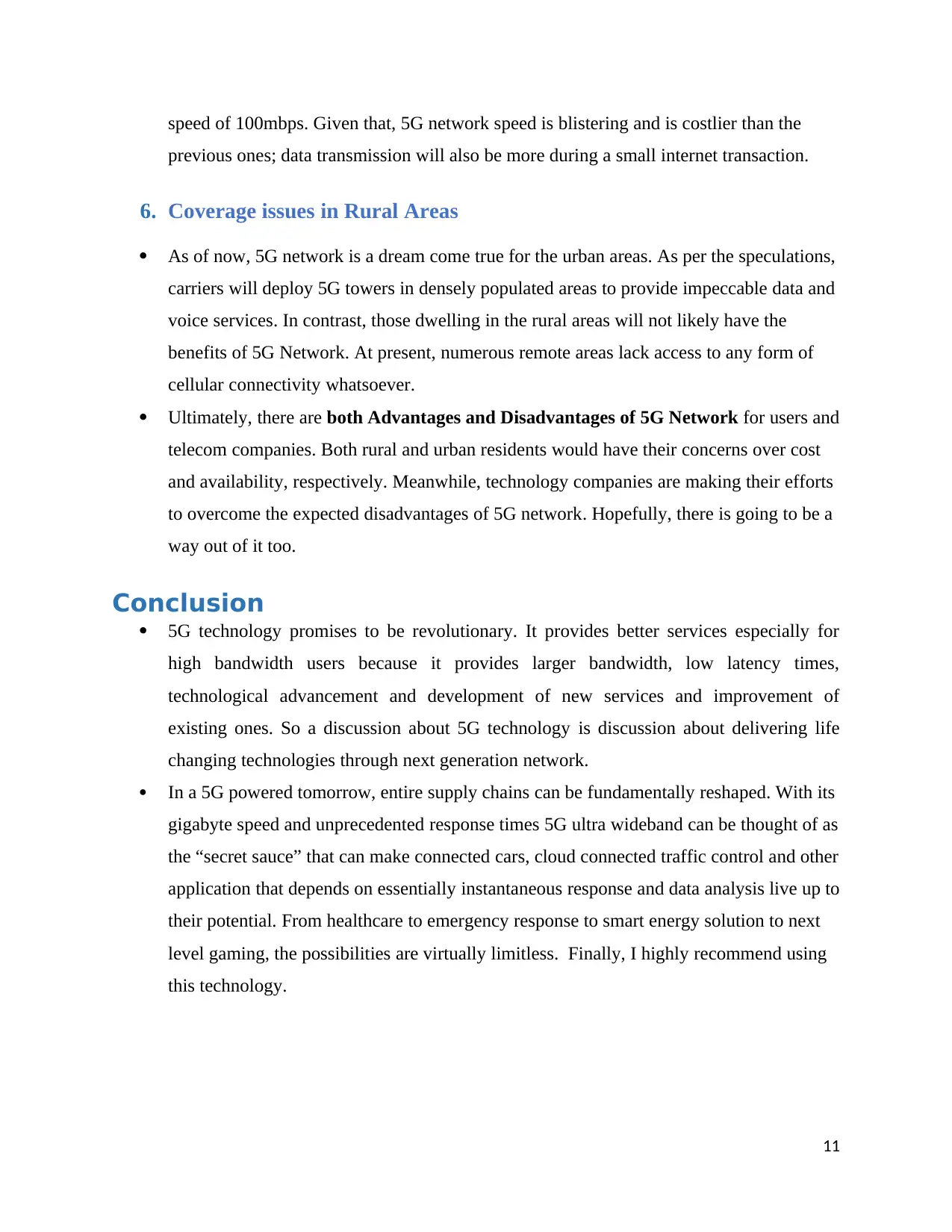
speed of 100mbps. Given that, 5G network speed is blistering and is costlier than the
previous ones; data transmission will also be more during a small internet transaction.
6. Coverage issues in Rural Areas
As of now, 5G network is a dream come true for the urban areas. As per the speculations,
carriers will deploy 5G towers in densely populated areas to provide impeccable data and
voice services. In contrast, those dwelling in the rural areas will not likely have the
benefits of 5G Network. At present, numerous remote areas lack access to any form of
cellular connectivity whatsoever.
Ultimately, there are both Advantages and Disadvantages of 5G Network for users and
telecom companies. Both rural and urban residents would have their concerns over cost
and availability, respectively. Meanwhile, technology companies are making their efforts
to overcome the expected disadvantages of 5G network. Hopefully, there is going to be a
way out of it too.
Conclusion
5G technology promises to be revolutionary. It provides better services especially for
high bandwidth users because it provides larger bandwidth, low latency times,
technological advancement and development of new services and improvement of
existing ones. So a discussion about 5G technology is discussion about delivering life
changing technologies through next generation network.
In a 5G powered tomorrow, entire supply chains can be fundamentally reshaped. With its
gigabyte speed and unprecedented response times 5G ultra wideband can be thought of as
the “secret sauce” that can make connected cars, cloud connected traffic control and other
application that depends on essentially instantaneous response and data analysis live up to
their potential. From healthcare to emergency response to smart energy solution to next
level gaming, the possibilities are virtually limitless. Finally, I highly recommend using
this technology.
11
previous ones; data transmission will also be more during a small internet transaction.
6. Coverage issues in Rural Areas
As of now, 5G network is a dream come true for the urban areas. As per the speculations,
carriers will deploy 5G towers in densely populated areas to provide impeccable data and
voice services. In contrast, those dwelling in the rural areas will not likely have the
benefits of 5G Network. At present, numerous remote areas lack access to any form of
cellular connectivity whatsoever.
Ultimately, there are both Advantages and Disadvantages of 5G Network for users and
telecom companies. Both rural and urban residents would have their concerns over cost
and availability, respectively. Meanwhile, technology companies are making their efforts
to overcome the expected disadvantages of 5G network. Hopefully, there is going to be a
way out of it too.
Conclusion
5G technology promises to be revolutionary. It provides better services especially for
high bandwidth users because it provides larger bandwidth, low latency times,
technological advancement and development of new services and improvement of
existing ones. So a discussion about 5G technology is discussion about delivering life
changing technologies through next generation network.
In a 5G powered tomorrow, entire supply chains can be fundamentally reshaped. With its
gigabyte speed and unprecedented response times 5G ultra wideband can be thought of as
the “secret sauce” that can make connected cars, cloud connected traffic control and other
application that depends on essentially instantaneous response and data analysis live up to
their potential. From healthcare to emergency response to smart energy solution to next
level gaming, the possibilities are virtually limitless. Finally, I highly recommend using
this technology.
11

Reference
http://www.emfexplained.info/?ID=25916
https://www.verizon.com/about/our-company/5g/what-5g
https://www.qualcomm.com/5g/what-is-5g#:~:text=5G%20will%20bring%20wider%20bandwidths,Gbps
%20throughput%2C%20and%20low%20latency.
https://www.google.com/amp/s/searchnetworking.techtarget.com/definition/5G%3famp=1
https://en.m.wikipedia.org/wiki/5G
https://www.digi.com/blog/post/5g-network-architecture?utm_source=subscribe&utm_medium=rss
https://www.rfpage.com/applications-5g-technology/
https://www.myayan.com/advantages-and-disadvantages-of-5g-network
12
http://www.emfexplained.info/?ID=25916
https://www.verizon.com/about/our-company/5g/what-5g
https://www.qualcomm.com/5g/what-is-5g#:~:text=5G%20will%20bring%20wider%20bandwidths,Gbps
%20throughput%2C%20and%20low%20latency.
https://www.google.com/amp/s/searchnetworking.techtarget.com/definition/5G%3famp=1
https://en.m.wikipedia.org/wiki/5G
https://www.digi.com/blog/post/5g-network-architecture?utm_source=subscribe&utm_medium=rss
https://www.rfpage.com/applications-5g-technology/
https://www.myayan.com/advantages-and-disadvantages-of-5g-network
12
1 out of 12
Related Documents
Your All-in-One AI-Powered Toolkit for Academic Success.
+13062052269
info@desklib.com
Available 24*7 on WhatsApp / Email
![[object Object]](/_next/static/media/star-bottom.7253800d.svg)
Unlock your academic potential
© 2024 | Zucol Services PVT LTD | All rights reserved.





